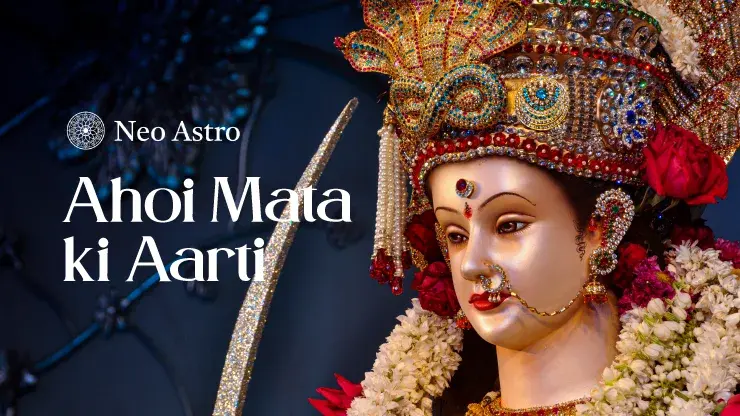Ahoi Mata Aarti Lyrics (अहोई माता आरती हिंदी में अर्थ सहित)

अहोई माता की आरती – हिंदी
जय अहोई माता, जय अहोई माता।
तुमको निसदिन ध्यावत, हर विष्णु विधाता॥
॥ जय अहोई माता…॥
ब्रह्माणी, रुद्राणी, कमला, तू ही है जगमाता।
सूर्य-चन्द्रमा ध्यावत, नारद ऋषि गाता॥
॥ जय अहोई माता…॥
माता रूप निरंजन, सुख-सम्पत्ति दाता।
जो कोई तुमको ध्यावत, नित मंगल पाता॥
॥ जय अहोई माता…॥
तू ही पाताल बसंती, तू ही है शुभदाता।
कर्म-प्रभाव प्रकाशक, जगनिधि से त्राता॥
॥ जय अहोई माता…॥
जिस घर थारो वासा, वाहि में गुण आता।
कर न सके सोई कर ले, मन नहीं घबराता॥
॥ जय अहोई माता…॥
तुम बिन सुख न होवे, न कोई पुत्र पाता।
खान-पान का वैभव, तुम बिन नहीं आता॥
॥ जय अहोई माता…॥
शुभ गुण सुंदर युक्ता, क्षीर निधि जाता।
रतन चतुर्दश तोकू, कोई नहीं पाता॥
॥ जय अहोई माता…॥
श्री अहोई माँ की आरती, जो कोई गाता।
उर उमंग अति उपजे, पाप उतर जाता॥
॥ जय अहोई माता, मैया जय अहोई माता॥
Ahoi Mata Aarti – English
Jai Ahoi Mata, Jai Ahoi Mata.
Tumko Nisdin Dhyavat, Har Vishnu Vidhata.
॥ Jai Ahoi Mata…॥
Brahmani, Rudrani, Kamla, Tu hi hai Jag Mata.
Surya - Chandrama Dhyavat, Narad Rishi Gaata.
॥ Jai Ahoi Mata…॥
Mata Roop Niranjan, Sukh - Sampatti Daata.
Jo koi Tumko Dhyavat, Nit Mangal Paata.
॥ Jai Ahoi Mata…॥
Tu hi Pataal Basanti, Tu hi hai Shubh Daata.
Karma - Prabhav Prakaashak, Jag Nidhi se Trata.
॥ Jai Ahoi Mata…॥
Jis Ghar Tharo Vaasa, Wahi mein Gunna Aata.
Kar na Sake Soi Kar Le, Mann Nahi Ghabraata.
॥ Jai Ahoi Mata…॥
Tum Bin Sukh Na Hove, Na Koi Putra Paata.
Khan-Paan ka Vaibhav, Tum Bin Nahi Aata.
॥ Jai Ahoi Mata…॥
Shubh Gun Sundar Yukta, Ksheer Nidhi Jaata.
Ratan Chaturdarsha Toku, Koi Nahi Paata.
॥ Jai Ahoi Mata…॥
Shri Ahoi Maa Ki Aarti, Jo Koi Gaata.
Ur Umang Ati Upje, Paap Utar Jaata.
॥ Jai Ahoi Mata, Maiyya Jai Ahoi Mata…॥
अहोई माता आरती का अर्थ (Meaning in Hindi)
यह आरती Ahoi Ashtami के अवसर पर गाई जाती है, विशेषकर मां बच्चों और संतान के कल्याण की कामना में। इसमें माता को जगमाता कहा गया है, जो ब्रह्मा-रुद्र-कमला के रूप से समस्त सृष्टि में वास करती हैं। “जिस घर थारो वासा, वाहि में गुण आता,” इस पंक्ति में यह विश्वास प्रकट है कि जिस घर में अहोई माता का वास हो, वहाँ शुभ गुण उत्पन्न होते हैं।
आरती में यह संदेश भी दिया गया है कि बिना माता की कृपा के स्वास्थ्य, सुख-सम्पत्ति, संतान एवं वैभव संभव नहीं है। माँ माता के प्रति समर्पण और भक्ति से पाप भी उतर जाते हैं, और जीवन में मंगल आता है। इस प्रकार यह आरती केवल भजन नहीं, बल्कि एक आध्यात्मिक प्रण और श्रद्धा-प्रकटिका है, जिसमें माता के आशीर्वाद से जीवन की अंधकार-स्थिति से प्रकाश-स्थिति में परिवर्तन की दिशा दर्शाई गई है।
| Download Ahoi Mata Aarti PDF |
Spiritual Significance of Ahoi Mata Ki Aarti
The Ahoi Mata Ki Aarti carries deep emotional and spiritual significance especially for mothers and families seeking the well-being of their children. On Ahoi Ashtami, devotees fast and worship Ahoi Mata (a form of the Divine Mother) to invoke her protection, longevity of children and wholesome family life. This sets the context for the aarti: when one sings “जय अहोई माता”, one is acknowledging that the Mother resides in every home and is the source of virtue, prosperity and safety.
Spiritually, this aarti reminds us of the maternal aspect of the divine, the ever-nurturing, ever-watchful principle which does not just provide material sustenance, but fosters moral strength, fear-lessness and devotion. The verse “उर उमंग अति उपजे, पाप उतर जाता” suggests that heartfelt devotion can purge guilt and negativity. Thus, singing this aarti is both an act of praise and a turning inward, recognising that by honouring the divine mother, we align ourselves with her qualities of compassion, protection and renewal.
When to Perform & Benefits of Ahoi Mata Aarti Lyrics
Worshipping Ahoi Mata through her aarti is considered one of the most heartfelt forms of devotion in Hindu tradition. It reflects a mother’s unconditional love and her prayer for the protection and prosperity of her children. The ritual not only strengthens family bonds but also purifies the home with faith, gratitude, and divine energy.
Best Timings:
The Ahoi Mata Ki Aarti is traditionally performed on Ahoi Ashtami, which falls on the eighth day (Ashtami) of the Krishna Paksha (waning phase of the moon) in the Hindu month of Kartik. This day holds immense spiritual significance, especially for mothers, as they observe a fast and perform this puja to seek the goddess’s blessings for the long life and well-being of their children.
The worship is generally conducted in the evening after sunset, once the stars appear in the sky. These stars are considered divine witnesses of a mother’s prayer, symbolising hope and the eternal bond between mother and child. Devotees often draw or paint the image of Ahoi Mata on the wall or on a piece of cloth, depicting her along with seven sons and a lion—a sign of strength, fertility, and divine protection. Lighting a ghee lamp (diya) and offering sweets, flowers, and water form part of the ritual before the aarti is sung.
Although Ahoi Ashtami is the principal day for this worship, many devotees also recite the Ahoi Mata Aarti on other auspicious days related to motherhood or family welfare. Performing it regularly, especially on Sundays or during Navratri, is believed to attract peace, prosperity, and happiness in the household.
Benefits:
- Invokes Ahoi Mata’s protection, ensuring the long life, health, and happiness of children.
- Creates a harmonious and sacred aura within the home, as expressed in “जिस घर थारो वासा, वाहि में गुण आता” (Where the Mother resides, virtues manifest naturally).
- Encourages mindfulness, patience, and emotional balance, especially among parents.
- Removes negativity, fear, and guilt, bringing inner peace and renewed hope.
- Promotes spiritual prosperity, purity of thought, and moral strength.
- Inspires gratitude, devotion, and surrender to the nurturing aspect of the Divine Mother.
How to Perform:
Clean and prepare a calm area in your home for the puja. Place or draw the image of Ahoi Mata on a wall or altar facing east. Light a ghee diya, offer flowers, sweets, rice grains, and water, and sit with devotion before the Mother’s image.
Recite the Ahoi Mata Ki Aarti slowly, focusing on each line with reverence. Visualise Ahoi Mata’s blessings flowing to your children and family members, filling your home with her divine energy. After the aarti, look toward the stars and offer a silent prayer of gratitude. Conclude the ritual by distributing prasad among the family.
Performing this aarti every Ahoi Ashtami or even weekly is believed to sustain happiness, health, and positive energy in the home, strengthening the sacred bond between the mother, her children, and the benevolent Ahoi Mata.
FAQs - Ahoi Mata Aarti
What is the best day to perform Ahoi Mata Aarti?

The most auspicious day is Ahoi Ashtami (eighth lunar day of the waning moon in Kartik). On this day mothers especially pray for their children’s well-being.
Can the Aarti be performed at any time or only on Ahoi Ashtami?

While it is primarily for Ahoi Ashtami, it can be performed on other days too when one seeks the blessings of Ahoi Mata for children or family welfare.
Do I need to know Sanskrit for this Aarti?

No. The aarti is available in Hindi and transliterated English, so you can recite it in a language you understand. The sincerity of devotion matters most.
What offerings are appropriate for Ahoi Mata Puja?

Simple offerings include water, red flowers, sweets, a lamp, and devotion. Drawing the image of Ahoi Mata on the wall or a cloth is a traditional step before the aarti.
How does this Aarti benefit children and families?

By performing the aarti, devotees symbolically invite the protective grace of Ahoi Mata into their homes, bringing a positive atmosphere, moral support and hope for children’s longevity and happiness.
Can the Aarti be sung collectively, e.g., in a temple or with family?

Absolutely. Ahoi Mata Aarti is often sung in groups, within families or in community gatherings to amplify devotion and collective goodwill.
